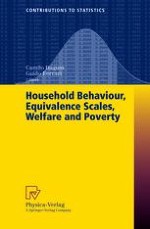2004 | OriginalPaper | Buchkapitel
Analysis and Measurement of Poverty. Univariate and Multivariate Approaches and Their Policy Implications. A Case Study: Italy
verfasst von : Camilo Dagum, Michele Costa
Erschienen in: Household Behaviour, Equivalence Scales, Welfare and Poverty
Verlag: Physica-Verlag HD
Enthalten in: Professional Book Archive
Aktivieren Sie unsere intelligente Suche, um passende Fachinhalte oder Patente zu finden.
Wählen Sie Textabschnitte aus um mit Künstlicher Intelligenz passenden Patente zu finden. powered by
Markieren Sie Textabschnitte, um KI-gestützt weitere passende Inhalte zu finden. powered by
This research presents and discusses the relative merits and limitations of the univariate and multivariate analyses and measurement of poverty to represent the state of poverty, the poverty ratio time path, and to assess the power of these approaches to identify the main causes of poverty and to inspire the proposal of sound socioeconomic policies. The univariate measurement of poverty analyses and estimates simple and composite poverty ratios advanced in the literature and their limitations to represent observed poverty time path and the lack of structural socioeconomic policy implications. The multivariate analysis of poverty advances forward the French social exclusion theory, and Sen’s analysis of functioning and capability, making them operational, in the sense of providing a poverty ratio and deriving its policy implications. In effect, to these analyses are applied the fuzzy set theory to obtain: (i) the poverty ratio of each household; (ii) the poverty ratio of a population of households; and (iii) very important for its policy implications, the poverty ratio of the population by retained attribute, such as, years of schooling of the household head and spouse (if present), house size and condition, and house endowment of sanitary and other services (drinking water, bath, electricity, etc.). Point (iii) allows the researcher to identify the main causes of structural poverty, i.e., the lack of those attributes that contribute to reproduce poverty from generation to generation. The outcome of this research is applied to the data base provided by the Bank of Italy sample surveys in 1993, 1995, 1998 and 2000, and a comparative analysis of the uni- and multi-variate approaches to the measurement of poverty and their policy implications for Italy completes this study.
